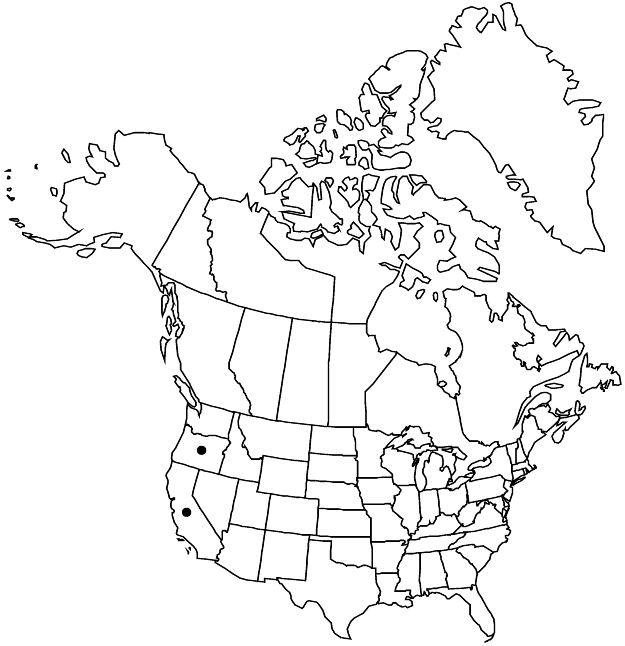Horkelia congesta
Bot. Mag. 56: plate 2880. 1829.
Plants tufted or rosette-forming, green to grayish green. Stems ascending to erect, 1.5–5 dm, hairs 2–3 mm proximally, glands dense distally. Basal leaves ± planar, (3–) 4–15 × 1–3 cm, usually villous at least abaxially, often densely so; stipules entire, deeply 2-lobed, or pinnately divided into 3–5 linear lobes; leaflets 2–6 per side, ± separate, narrowly cuneate or lanceolate-elliptic to oblong, 5–20 × (1–) 2–5 (–6) mm, 1/5–1/2 as wide as long, divided 1/6–1/4 or less to midrib into (0–) 3 (–5) ± ovate teeth 1–2 mm wide, these restricted to apex. Cauline leaves 2–7; stipules 5–25 (–30) mm, divided 3/4+ into linear or linear-lanceolate lobes, or incompletely divided or divided no more than 2/3 into lanceolate, often acuminate teeth. Inflorescences open to congested, flowers usually arranged in ± capitate glomerules or corymbiform clusters. Pedicels 1–3 (–6) mm. Flowers 8–16 mm diam.; epicalyx bractlets linear to lanceolate or narrowly elliptic, 1–3 × 0.3–0.8 mm, ± 2/3 length of sepals; hypanthium 2–2.5 × 3–4.5 mm, ± 1/2 to nearly as deep as wide, interior usually glabrous, sometimes sparsely pilose; sepals spreading, abaxially green, 2–4.5 mm; petals white to cream, ± obovate, (2.5–) 3–6 × (1.5–) 2–5 mm, apex ± rounded to ± emarginate; filaments (0.5–) 1–2 × (0.2–) 0.4–0.6 mm, anthers 0.4–0.7 (–1) mm; carpels (6–) 10–15 (–20), styles 1.5–3 mm. Achenes brown, 1.6–2.2 mm, faintly rugose.
Distribution

Calif., Oreg.
Discussion
Varieties 2 (2 in the flora).
As discussed by D. D. Keck (1938) and analyzed by T. N. Kaye (unpubl., Oregon Dept. of Agriculture, 1995), Horkelia congesta comprises three population clusters that form a latitudinal gradient in Oregon west of the Cascade Range, transitioning to H. tridentata in the mountains of California. Populations of H. congesta in remnant prairies in the Willamette Valley (probably including the type of H. hirsuta Lindley) have relatively tall, erect stems, pectinate stipules, relatively numerous, narrow leaflets, openly branched inflorescences with flowers in corymbiform clusters, and clawed petals 5–6 × 4–5 mm. In contrast, populations centered in rocky serpentine flats within the Illinois River drainage in Josephine County, which were described by Keck as subsp. nemorosa, tend to have shorter ascending stems, less divided stipules, fewer and broader leaflets, more capitate inflorescences, and scarcely clawed petals 3–4 × 2–3 mm. The differences between these two extremes are blurred by populations from the Umpqua Valley in Douglas County (the probable type locality of H. congesta), as well as scattered populations in northern Jackson and Josephine counties. Based on morphometric analyses of 19 characters, Kaye concluded that the Umpqua material overlapped slightly with plants from the Willamette Valley, while the Josephine County populations clustered separately. He retained the Umpqua and Willamette valley populations as subsp. congesta, with mid stem stipule features of greatest diagnostic value. This taxonomic conclusion is adopted here, with a change of rank from subspecies to variety.
Selected References
None.
Key
| 1 | Cauline leaves: stipules divided 3/4+ into linear to linear-lanceolate lobes; inflorescences composed of ± corymbiform clusters to capitate glomerules; petals (3–)4–6 × (2–)3–5 mm; remnant prairies, Willamette and Umpqua valleys, Oregon. | Horkelia congesta var. congesta |
| 1 | Cauline leaves: stipules incompletely divided or divided no more than 2/3 into lanceolate, often acuminate teeth; inflorescences usually composed of ± capitate glomerules; petals 2.5–3(–4) × (1.5–)2–3 mm; serpentine flats, Illinois River drainage, Oregon, and Del Norte County, California. | Horkelia congesta var. nemorosa |
"thin" is not a number.No values specified."dm" is not declared as a valid unit of measurement for this property."dm" is not declared as a valid unit of measurement for this property.